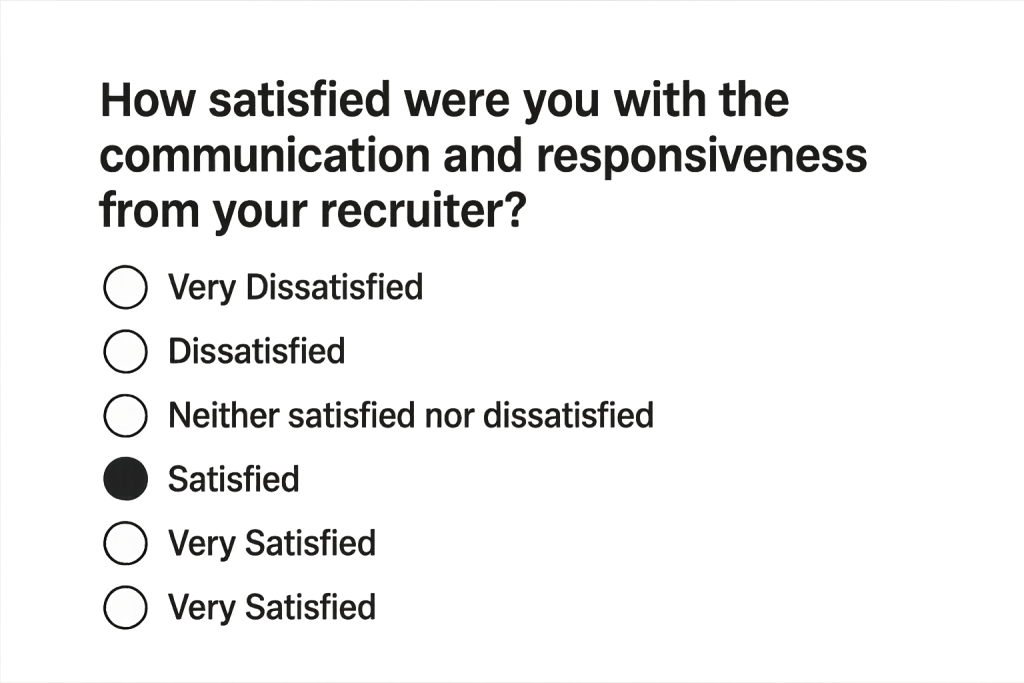Understanding candidate experience is useful—it helps organizations improve the hiring process, which in turn attracts more and better candidates. While third-party sites like Glassdoor offer some insights, organizations can gather higher-quality data by collecting it systematically.
Traditional Approaches
The most common methods for gathering candidate experience data are surveys and process metrics. Process metrics include data such as where candidates drop off in the application process and how long various stages take. These are relatively easy to collect and offer quantitative insights. However, hiring managers are typically more interested in candidates’ opinions, which leads us to surveys.
Surveys can be as simple as a tool like SurveyMonkey or more specialized platforms like Starred.com and Survale. At their core, these surveys emphasize multiple-choice questions.
For example:

This provides useful quantitative data, but if someone selects “Dissatisfied,” you’ll want to know why.
The traditional tools offer branching logic and open-ended questions to get more detailed feedback but the new AI tools have the potential to take this even further. That potential is worth exploring.
Using AI for a Conversational Approach
Ideally, we’d like to talk to every candidate, understand what went well or didn’t, and learn how to improve. Human-to-human conversations aren’t scalable—but AI can help. Imagine how an AI-driven tool might conduct a dialogue:
AI Recruiter: Was there any part of the process that left you second-guessing your decision?
Candidate: I wasn’t sure where I stood after the panel interview. It was intense, and there
wasn’t much feedback.
AI Recruiter: What kind of feedback would have made that stage clearer?
Candidate: Maybe a note explaining what the panel was looking for—or a heads-up that
silence didn’t mean a problem.
AI Recruiter: Do you feel the interview was too intense, or was it appropriate for this kind of
job?
Candidate: Intense interviews are good, they show the company is serious, it’s just the lack of
feedback that bothered me.
This kind of dialogue yields richer feedback than multiple-choice questions and standard open-ended questions alone.
Analyzing Conversational Data
AI tools can collect a wealth of comments—but that creates a new challenge: analysis. Again, AI offers a solution. These tools can summarize themes, flag insightful responses, and track sentiment. What could be overwhelming becomes a manageable set of insights.
Organizations will likely want to use a hybrid approach of quantitative data from multiple-choice questions, and deeper dives into the details with AI-driven conversational data.
The State of AI Tools
The notion of using AI tools to drive conversations is not speculative. For example,
AfterCare, a New York-based startup provides this kind of tool. More vendors are likely to follow. Pricing is typically affordable, ($25/month for 500 responses) so the real question isn’t cost—it’s whether you’re ready to invest time in using a tool that delivers deeper insights.
Perhaps the deeper question is whether you want to explore the world of AI at every opportunity since it clearly is the path to the future. It may be that you are already getting helpful comments in open-ended questions, or perhaps you will discover that it’s more work coaxing the AI to ask good follow-up questions than you would like. However, my view is that the ROI of using a new AI tool isn’t mainly in the performance of the tool itself. The value comes from developing a clear understanding of what these tools can do now and what they are likely to be able to do in the future. AI will change everything in recruiting, assessing candidate experience is just one example of what AI is capable of. We need to be aggressive in learning about AI or risk being left behind.
